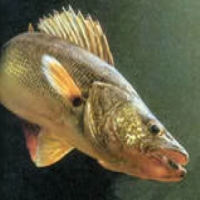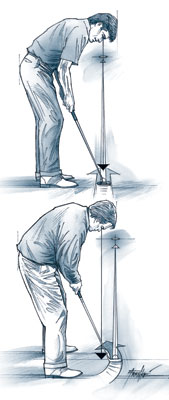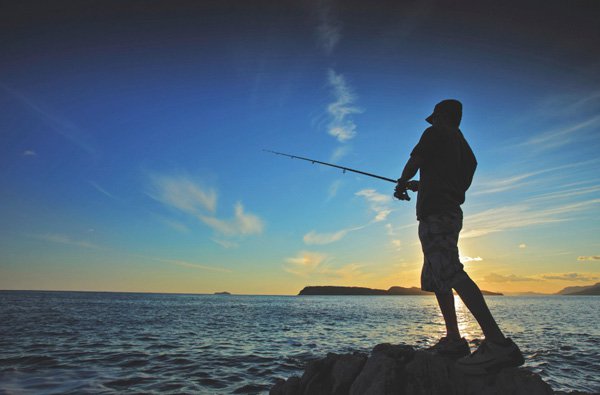Before I get into this, lets just understand that I consider any jig 1/4oz or larger to be heavy. Catch 10,000 bass or so on a 1/16, 1/8 and 3/16oz jigs and you would also. When fishing heavy jigs, I abandon the realm of spinning tackle and move up to stout bait casting gear. This is necessary to transport your offering to nasty places and to get it back. I normally do not skip with a bait casting rod. It can be done but you must have an extremely educated thumb to prevent backlashes. I use Shimano reels exclusively. I go with either a Scorpion 1001 or a Calais Antares 101.
Contrary to many other anglers, I do not use a very heavy line 10 or 12lb line fills the bill for me and can handle most situations. I like Hybrid line. Gamakatsu G-Lock is also very good for flipping. I have used Vanish fluorocarbon and I like it also. It has great abrasion resistance. I only tie my jigs on with a palomar knot. I feel this is the strongest most reliable knot anyone can tie. I rely on Kistler Helium rods. I prefer a medium action rod. The lighter line and medium action rod make this a light line method when compared to the 25 and 20lb test many guys are using. I've been doing a ton of flipping with a 6-6 ML rod and Scorpion 1001 reel. I usually do not go above a 3/16oz jig but it is a dynamite combo. It is sheer fun. I've never broken a rod while fishing jigs.
Targeting Bass
I can flip, I can Skip, I can pitch. Which is best? Do what works for you. I am more effective skipping with a spinning rod so I usually do not skip with bait casting rods. My presentation is a cross between flipping and pitching. It is a kind of under hand lob low to the water that may be skipping-like in reality. When the bait hits the water, there is very little disturbance.
I am always searching for targets to hit. I will drop jigs into places many guys won't. You can't worry about losing a bait. If you do, you will handicap yourself mentally. Putting jigs in tough places can mean the difference between catching a horse and casting practice. I hit my targets from many different angles. This gives the fish a presentation it may not have seen. I see far too many guys drop a jig on a stump once or twice only to move on. I do not fish my jig back to the boat. Once I feel I have saturated the target, I reel in and cast again.
Strikes range from a mushy weighty feeling to an unmistakable chomp. I learned to fish jigs by forcing myself to only take them with me while fishing. I learned early on to discern what the jig felt like on the end of my line. Anything lighter or heavier was surely a bass. This is what I have come to name ?Weighing the line?. I learned what a 3/16oz jig feels like in the water. This strategy has helped me learn complex techniques and has definitely made me a better, more consistent angler.
Let's talk about hook sets. If you are fishing a jig correctly, you will have very little slack line. It is a contact bait in which an angler must know what it is doing at all times. This makes for instantaneous hook sets and excellent sensitivity. If you feel something out of the ordinary, swing on it, hook sets are free. I set my hook hard over my right shoulder. It is violent, it is lightning quick and it gets the job done. I notice that very few anglers get the gist of the hook set in most applications. There is no pussy footing around here, set it like you mean it or go home empty handed. There really is no style to it, just speed and power.
Detecting a strike will come as a natural feeling in time and with practice. The time it takes you to detect a strike and swing on it is the difference between hooking up and getting beaned in the head by your jig. A jig is made of metal and silicone. A bass will rarely hold on to it for a long period of time. Scent and salt may help increase the odds by a half second or so but it is important to set up as soon as you detect the strike.
Rattles
Rattles may give the angler an advantage when the water is murky or cold. I prefer to fish without rattles 95% of the time. When I use them, I prefer the strap type of collar so the rattles hang down in the skirt. This way they do not impede with my hook set. One little trick I employ is to add a small piece of sponge on the hook shank. I spray it with a bit of garlic or craw scent. I think it at least gives me the confidence to be more effective.
A jig is a contact bait. It is built be used in nasty places and it is strong enough to wrestle big bass out of them. Many guys make the mistake of not attempting to penetrate deep into cover with them. By failing to do this, they decrease their chances for success. You've got to get into the places where these fish live.
Although I am a light tackle jig guy by nature, I'm smart enough to realize that heavy jigs definitely have a place in my arsenal. On the other side of it, don't just use heavier baits. You will be pleasantly surprised when you tie on a light jig n pig.



Copyright © www.mycheapnfljerseys.com Outdoor sports All Rights Reserved